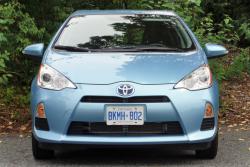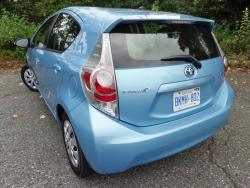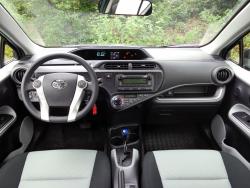There are many reasons to like the Toyota Prius c hybrid, the smaller sibling of the mid-size Prius and Prius v models. Starting at $20,440, the Prius c is the lowest price hybrid car in the Canadian market. It’s also the most fuel efficient (non plug-in) hybrid available (tied with the bigger Prius) with city/highway fuel economy ratings of 4.4 L/100 km and 5.1 L/100 km, according to the EPA. It seats five passengers in a pinch, and has the convenience and versatility of a hatchback body style. And its predicted reliability is “much better than average” according to Consumer Reports.
Still, the Prius c has had its fair share of criticism from car reviewers. In our long-term test of the 2012 Prius c (which is essentially the same as the current year model), we found it noisy and underpowered under full throttle, with a wide turning circle that made it difficult to do u-turns (with the optional 16-inch tires). The outward visibility to the rear is restricted by its sloping roof, especially if you’re tall in the saddle. Inside, the optional synthetic leather seats, hard interior plastics and climate display all look rather cheap, the centre information display can prove distracting while driving, and rear seating space is limited. Lastly, we noted that the Prius c is considerably more expensive than other (non-hybrid) subcompact cars.
Some of this is to be expected: hybrids have always been more expensive than similarly-sized non-hybrid vehicles and generally, money saved on gas bills won’t pay for the difference in the vehicle retail prices for many, many years. Hybrid gasoline-electric powertrains too, have traditionally presented a less satisfying driving experience than standard powertrains, due chiefly due to the emphasis on fuel economy rather than performance and the annoying high-revving engine droning caused by single-speed continuously variable transmissions.
But while compromises made to achieve the Prius c’s outstanding fuel economy will be a deal breaker for some, others will overlook them in return for its state-of-the-art hybrid technology, reduced greenhouse gas emissions, and low fuel costs. A lot depends on just how “green” the buyer wants to be.
From a practical point of view, the Prius c’s subcompact dimensions make it city-friendly: it’s easy to manoeuvre in traffic, easy to park, and equipped with the standard 15-inch tires (as our test car was), has a smaller turning circle (9.6 m) than with the optional 16-inch tires. The Prius c’s visibility to the front and sides is good, but the narrow rear window does obscure some of the rear view, and the lack of a rear-view camera seems odd in a car that has a standard 3.5-inch screen in the instrument panel. A standard rear wiper with intermittent wipe setting and electric washer will prove invaluable when the snow and slush starts to fly.
   2014 Toyota Prius c, dashboard. Click image to enlarge |
Though the Prius c’s ride can be stiff and road noise intrusive, the Prius c is more enjoyable to drive than its bigger cousins, the Prius and Prius V. It’s about 250 kg (540 lbs) lighter than a regular Prius Liftback, and feels more nimble as a result. The Prius c’s fuel tank and hybrid battery are positioned underneath the rear seat within the wheelbase which helps weight distribution and handling. Our tester had standard 175/65R15-inch tires which proved adequate, but Technology trim models are equipped with the larger, lower profile 195/50R16-inch tires and a faster steering ratio. Still, you won’t find the Prius c’s handling as nimble or the steering as sharp as in a non-hybrid subcompact like the Honda Fit or Mazda2.

















